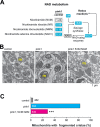Enhancing NAD+ salvage metabolism is neuroprotective in a PINK1 model of Parkinson's disease
- PMID: 28011627
- PMCID: PMC5312101
- DOI: 10.1242/bio.022186
Enhancing NAD+ salvage metabolism is neuroprotective in a PINK1 model of Parkinson's disease
Abstract
Familial forms of Parkinson's disease (PD) caused by mutations in PINK1 are linked to mitochondrial impairment. Defective mitochondria are also found in Drosophila models of PD with pink1 mutations. The co-enzyme nicotinamide adenine dinucleotide (NAD+) is essential for both generating energy in mitochondria and nuclear DNA repair through NAD+-consuming poly(ADP-ribose) polymerases (PARPs). We found alterations in NAD+ salvage metabolism in Drosophila pink1 mutants and showed that a diet supplemented with the NAD+ precursor nicotinamide rescued mitochondrial defects and protected neurons from degeneration. Additionally, a mutation of Parp improved mitochondrial function and was neuroprotective in the pink1 mutants. We conclude that enhancing the availability of NAD+ by either the use of a diet supplemented with NAD+ precursors or the inhibition of NAD+-dependent enzymes, such as PARPs, which compete with mitochondria for NAD+, is a viable approach to preventing neurotoxicity associated with mitochondrial defects.
Keywords: Drosophila; Mitochondria; NAD+; NAM; Niacin; Nucleotide metabolism; PARP; PINK1; Parkinson's disease.
© 2017. Published by The Company of Biologists Ltd.
Conflict of interest statement
The authors declare no competing or financial interests.
Figures




References
Grants and funding
LinkOut - more resources
Full Text Sources
Other Literature Sources
Molecular Biology Databases

